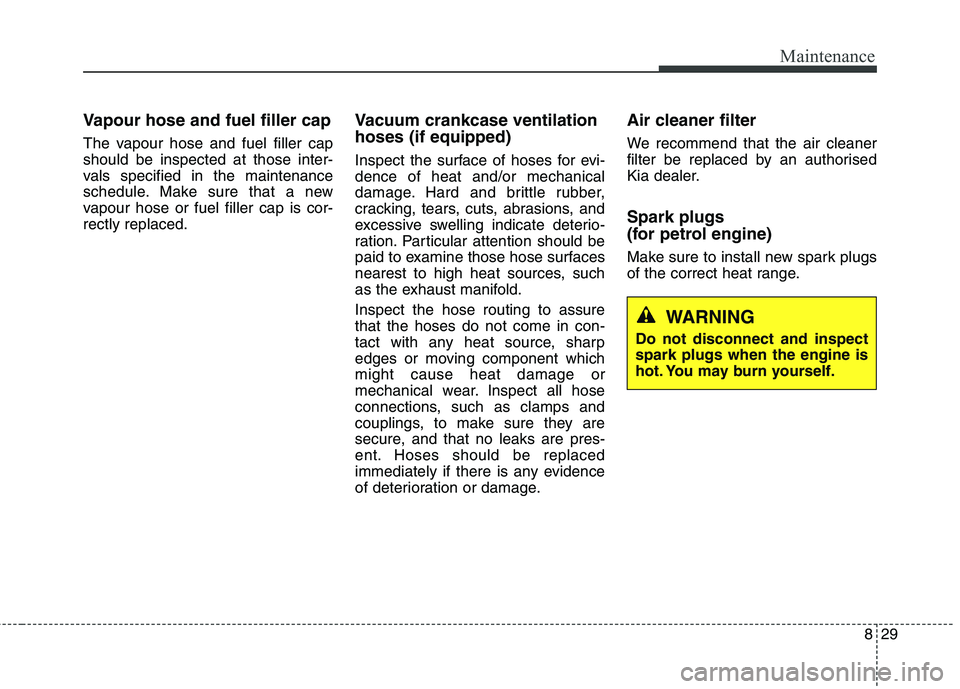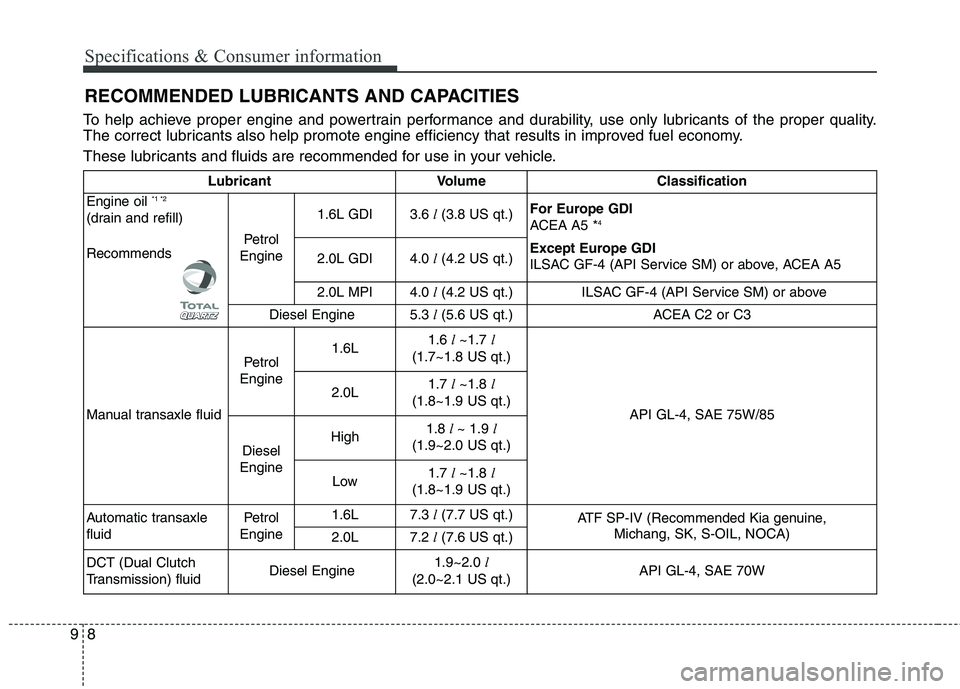Page 550 of 723

6115
Driving your vehicle
The Certification/Tyre label is found on the front edge of the RH (or LH)
“B” pillar. The label shows the size of
your original tyres and inflation pres-
sures needed to obtain the gross
weight capacity of your vehicle. This is called the GVWR (Gross
Vehicle Weight Rating). The GVWR
includes the weight of the vehicle, all
occupants, fuel and cargo. The
Certification/Tyre label also tells you
the maximum weights for the front
and rear axles, called Gross Axle
Weight Rating (GAWR).
Never exceed the GVWR for your
vehicle, or the Gross Axle Weight
Rating (GAWR) for either the front or
rear axle. And, if you do have a
heavy load, you should spread it out.
✽✽NOTICE
Your warranty does not cover parts
or components that fail because of
overloading.
CAUTION
Do not load your vehicle any heavier than the GVWR or themaximum front and rear GAWRs. If you do, change to the vehiclemay occur, or it can change theway your vehicle handles. These could cause you to lose control.Also, overloading can shortenthe life of your vehicle.
Page 592 of 723
85
Maintenance
1. Engine oil filler cap
2. Brake/clutch fluid reservoir
3. Positive battery terminal
4. Negative battery terminal
5. Fuse box
6. Air cleaner
7. Radiator cap
8. Engine coolant reservoir
9. Engine oil dipstick
10. Windscreen washer fluid reservoir
11. Fuel filter
ORP076083R
❈
The actual engine room in the vehicle may differ from the illustration.
■■
Diesel engine - 1.7L
Page 602 of 723
815
Maintenance
Normal Maintenance Schedule - For Europe (Except Russia) (Continue)
I : Inspect and if necessary, adjust, correct, clean or replace.
R : Replace or change.
MAINTENANCE INTERVALS
MAINTENANCE ITEMNumber of months or driving distance, whichever comes first
Months24487296120144168192
Miles×1,00020406080100120140160
Km×1,000306090120150180210240
Fuel lines, hoses and connectionsPetrol-I-I-I-I
DieselIIIIIIII
Fuel tank air filter(if equipped)Petrol-I-I-I-I
Vapor hose and fuel filler cap-I-I-I-I
Air cleaner filterIRIRIRIR
Vapor hose and fuel filler cap-I-I-I-I
Air cleaner filterIRIRIRIR
Exhaust systemIIIIIIII
Cooling system At first, Inspect 60,000 km (40,000 miles) or 48 months
after that, Inspect every 30,000 km (20,000 miles) or 24 months
Air conditioner refrigerant/compressor (if equipped)IIIIIIII
Climate control air filter (if equipped)-R-R-R-R
Brake discs and padsIIIIIIII
Brake lines, hoses and connectionsIIIIIIII
Page 610 of 723

823
Maintenance
Normal Maintenance Schedule - Except Europe (Including Russia) (Continue)
MAINTENANCE INTERVALS
MAINTENANCE ITEMNumber of months or driving distance, whichever comes first
Months1224364860728496
Miles×1,0001020304050607080
Km×1,000153045607590105120
Valve clearance(Except for Nu 2.0 Engine) * 9Inspect every 90,000 Km (60,000 miles) or 72 months
Spark plugsPetrol - Iridium *10
Replace every 160,000 km (104,000 miles) or 120months
Petrol - NickelRR
Automatic transaxle fluid (if equipped)No check, No service required
Manual transaxle fluid (if equipped) * 3II
Dual clutch transmission fluid (if equipped) * 3II
Drive shafts and bootsIIII
Fuel additives (Petrol) *6Add every 10,000 km (6,500 miles) or 6 months (For Australia and
New Zealand : Add every 15,000 km (10,000 miles) or 12 months
Fuel filter (Petrol) * 8For China, BrazilIRIR
Fuel filter cartridge (Diesel) * 7RRRR
Fuel lines, hoses and connectionsPetrolII
DieselIIII
Fuel tank air filter (if equipped)PetrolIRIR
Vapor hose and fuel filler capPetrolII
Fuel filler cap (Diesel)DieselII
I : Inspect and if necessary, adjust, correct, clean or replace. R : Replace or change.
Page 616 of 723

829
Maintenance
Vapour hose and fuel filler cap
The vapour hose and fuel filler cap should be inspected at those inter-
vals specified in the maintenance
schedule. Make sure that a new
vapour hose or fuel filler cap is cor-rectly replaced.Vacuum crankcase ventilation hoses (if equipped)
Inspect the surface of hoses for evi- dence of heat and/or mechanical
damage. Hard and brittle rubber,
cracking, tears, cuts, abrasions, and
excessive swelling indicate deterio-
ration. Particular attention should be
paid to examine those hose surfaces
nearest to high heat sources, such
as the exhaust manifold. Inspect the hose routing to assure that the hoses do not come in con-
tact with any heat source, sharp
edges or moving component whichmight cause heat damage or
mechanical wear. Inspect all hose
connections, such as clamps and
couplings, to make sure they are
secure, and that no leaks are pres-
ent. Hoses should be replaced
immediately if there is any evidence
of deterioration or damage.Air cleaner filter
We recommend that the air cleaner
filter be replaced by an authorised
Kia dealer. Spark plugs
(for petrol engine)
Make sure to install new spark plugs
of the correct heat range.
WARNING
Do not disconnect and inspect spark plugs when the engine is
hot. You may burn yourself.
Page 696 of 723

8109
Maintenance
EMISSION CONTROL SYSTEM
The emission control system of your
vehicle is covered by a written limited
warranty. Please see the warranty
information contained in the Service
Passport in your vehicle.
Your vehicle is equipped with an emission control system to meet all
emission regulations. There are three emission control
systems which are as follows.
(1) Crankcase emission control sys- tem
(2) Evaporative emission control sys- tem
(3) Exhaust emission control systemIn order to assure the proper function
of the emission control systems, it is
recommended that you have your
car inspected and maintained by an
authorised Kia dealer in accordance
with the maintenance schedule. Caution for the Inspection and
Maintenance Test (With Electronic
Stability Control (ESC) system)
To prevent the vehicle from mis-
firing during dynamometer test-
ing, turn the Electronic Stability
Control (ESC) system off by
pressing the ESC switch.
After dynamometer testing is completed, turn the ESC system
back on by pressing the ESC
switch again.
1. Crankcase emission control system
The positive crankcase ventilation
system is employed to prevent air
pollution caused by blow-by gases
being emitted from the crankcase.This system supplies fresh filtered air
to the crankcase through the air
intake hose. Inside the crankcase,
the fresh air mixes with blow-by
gases, which then pass through the
PCV valve into the induction system. 2. Evaporative emission con-
trol System
The Evaporative Emission Control
System is designed to prevent fuel
vapours from escaping into the
atmosphere.
Canister
Fuel vapours generated inside the fuel tank are absorbed and stored in
the onboard canister. When the
engine is running, the fuel vapours
absorbed in the canister are drawninto the surge tank through the purge
control solenoid valve.
Purge Control Solenoid Valve (PCSV)
The purge control solenoid valve is
controlled by the Engine Control
Module (ECM); when the engine
coolant temperature is low during
idling, the PCSV closes so that evap-
orated fuel is not taken into the
engine. After the engine warms-up
during ordinary driving, the PCSV
opens to introduce evaporated fuel to
the engine.
Page 707 of 723

Specifications & Consumer information
8
9
RECOMMENDED LUBRICANTS AND CAPACITIES
To help achieve proper engine and powertrain performance and durability, use only lubricants of the proper quality.
The correct lubricants also help promote engine efficiency that results in improved fuel economy.
These lubricants and fluids are recommended for use in your vehicle.
Lubricant Volume Classification
Engine oil *1 *2
(drain and refill) Recommends Petrol
Engine 1.6L GDI
3.6
l(3.8 US qt.) For Europe GDI
ACEA A5 *
4
Except Europe GDI
ILSAC GF-4 (API Service SM) or above, ACEA A5
2.0L GDI
4.0
l(4.2 US qt.)
2.0L MPI4.0 l(4.2 US qt.)ILSAC GF-4 (API Service SM) or above
Diesel Engine 5.3
l(5.6 US qt.)
ACEA C2 or C3
Manual transaxle fluid Petrol
Engine 1.6L
1.6
l~1.7 l
(1.7~1.8 US qt.)
API GL-4, SAE 75W/85
2.0L1.7 l~1.8 l
(1.8~1.9 US qt.)
Diesel
Engine High
1.8
l ~ 1.9 l
(1.9~2.0 US qt.)
Low 1.7
l~1.8 l
(1.8~1.9 US qt.)
Automatic transaxle fluid Petrol
Engine 1.6L
7.3
l(7.7 US qt.)
ATF SP-IV (Recommended Kia genuine,
Michang, SK, S-OIL, NOCA)
2.0L 7.2
l(7.6 US qt.)
DCT (Dual Clutch
Transmission) fluid Diesel Engine1.9~2.0
l
(2.0~2.1 US qt.) API GL-4, SAE 70W